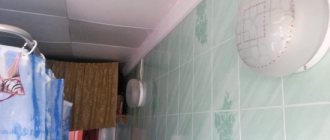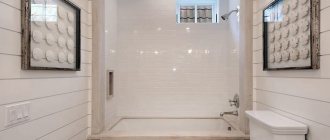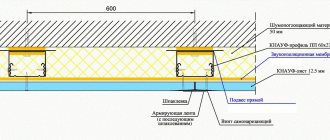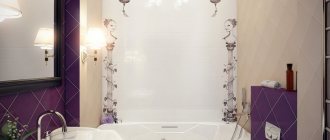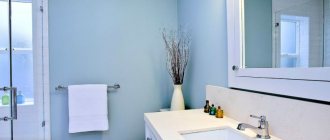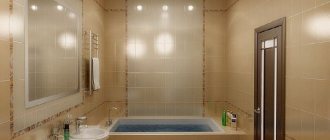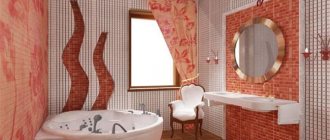Why is moisture-resistant putty needed?
Often, preparing the surface for finishing involves leveling uneven areas and applying a layer of putty. But it is important to select the purpose and type of mixture depending on the room. Not every putty is suitable for a wet room. If it is chosen incorrectly, the entire repair will not live up to expectations. Therefore, it is imperative to use moisture-resistant putty for the bath.
It is applied to all surfaces that are exposed to water and moisture in various forms. So, this can be the direct contact of water or moisture on the surface, the formation of evaporation or condensation. If you do not treat the walls and ceiling with this composition, the paint will peel off very quickly, and the entire repair will not justify the investment and everything will have to be redone.
Putty for wet rooms should be used not only in the bathroom and toilet. It is ideal for the kitchen, pool and bathhouse. The cost of such material is slightly higher than usual, but it pays off almost instantly after the repair is completed. Mold will not appear under the ceramic tiles, and the paint will last a very long time and will not lose its original shade. The surface will remain perfectly flat, which is important for subsequent decorative finishing.
Requirements for putty materials
In addition to such parameters, you need to take into account the requirements that the putty for the bathroom must meet. The most important parameters are:
- The characteristics of such materials should not change during operation at high humidity. The ideal situation is when a wet environment strengthens the surface with a thin layer of putty.
- Such compositions should be as durable as possible. In this case, the optimal service life can be considered to be at least 20 years.
- After polymerization, the applied layer should not be subject to thermal deformation.
Main types
Waterproof putty for the bathroom is available in several types. Each mixture has its own advantages, which are necessary for certain conditions. To choose the right option, you need to familiarize yourself with the main putty options:
- Cement. This is a material with increased resistance to moisture. This composition is ideal for application to the walls and ceiling in the bathroom of a house or apartment. Cement putty is inexpensive, which makes it accessible to most buyers. Negative aspects include a grayish tint and a grainy structure. It should not be used in combination with white or other light-colored paint.
- Plaster. This bathroom putty has a pleasant light shade. The mixture dries quickly and ideally prepares the surface for painting with pastel colors. The putty is applied in an even layer, which makes subsequent finishing easier. But this material is used only for indoor work. It is not suitable for working with facades. This is due to the fact that gypsum does not tolerate temperature changes well.
- Polymer. This finishing mixture represents an advanced development. It consists of high-tech particles, and the process is high-tech particles, and the polymerization process is carried out in contact with air. The moisture-resistant putty remains plastic for a long time, so you can work with it slowly. But with such compounds a respirator is required.
- Oil-glue. This material is a powder mixture that requires dilution. This putty layer is ideal for utility rooms that do not need high-quality repairs.
On video: how to plaster the walls in the bathroom.
Insulation materials
58 votes
+
Vote for!
—
Vote against!
The bathroom is a room with high humidity, therefore, for finishing the walls, it is necessary to use a special moisture-resistant putty. This composition, when exposed to moisture, improves performance characteristics and becomes more durable. We will learn further about how to finish the walls in the bathroom using moisture-resistant putty.
Table of contents:
- Moisture-resistant putty for the bathroom: application features
- Moisture-resistant putty for drywall: selection and characteristics
- Moisture-resistant putty price and application tool
- Bathroom putty for painting: application features
Moisture-resistant putty for the bathroom: application features
The putty used to finish the walls in the bathroom must have certain properties that ensure the quality of its use. Regardless of the further finishing of the walls in the room, the putty for the walls in the bathroom should be:
- resistant to moisture - ordinary putty, under the influence of moisture it swells, peels off, deforms and generally collapses, while moisture-resistant materials should become stronger under the influence of moisture;
- long-lasting - the minimum service life of the putty after its application to the walls should be twenty years;
- resistant to changes in temperature - since the bathroom is a room with an unstable temperature regime, the putty for walls should easily tolerate these fluctuations; expansion and contraction of the putty when the temperature changes leads to its destruction.
Please note that these criteria are decisive when choosing a putty composition for finishing bathroom walls. Individual additions depend on further wall finishing. So, for example, if after finishing the walls in the bathroom are painted, then the surface should be perfectly even, which means the putty should fit perfectly on the wall. For walls finished with tiles, this criterion is less important.
To decorate the walls in the bathroom, the following compositions with a mineral or polymer base are used:
1. Cement-based bathroom putty.
For the manufacture of this composition, high quality Portland cement is used. When exposed to moisture, it becomes even more durable and strong. The coating, after being applied to the wall, is additionally moistened with water. The main components of this composition, in addition to cement, are fine sand and clinker chips. In order to improve the plasticity of the composition, various additives and fillers are added to it.
2. Acrylic or latex putty compositions based on polymers.
Consists of various types of mineral and synthetic additives. This composition is characterized by greater plasticity than cement. It does not shrink and is easily applied to the wall, spreading on its surface. However, the cost of such putty is an order of magnitude higher than that of its cement counterpart.
Some experts use façade putty to decorate bathroom walls. However, before purchasing a product, make sure that it does not contain harmful or toxic substances.
Gypsum-based mixtures are not recommended for use on bathroom walls under any circumstances, despite the fact that some of these compositions are also labeled as moisture-resistant. This type of finishing is not able to withstand constant steam and changes in room temperature.
When answering the question of which bath putty to choose, we definitely recommend choosing an acrylic or latex version of the composition. If the cost of the composition is critical for you, then purchase a cement-based putty with moisture-resistant characteristics.
Moisture-resistant putty for drywall: selection and characteristics
Depending on its purpose, drywall putty is divided into types:
1. Moisture-resistant finishing putty - often sold in ready-made form, used for final finishing of indoor walls. After finishing with the finishing compound, the walls are prepared for painting.
2. Moisture-resistant leveling putty - used for the initial leveling of the wall, this composition allows you to get rid of joints between sheets, holes for fasteners, etc.
3. Universal putty compounds - allow you to perform leveling and final finishing at the same time.
In relation to the composition, moisture-resistant bathroom putty is:
1. Compositions based on gypsum - do not shrink, but have poor moisture-resistant characteristics.
2. Cement compositions - have excellent moisture resistance, resist mechanical stress well, but they shrink slightly. With the help of such compositions, the walls in the bathroom are decorated with tiles.
3. Polymer putty mixtures are the best option for perfectly leveling walls. The putty has high plasticity and is well distributed on the wall, leveling it. The only drawback is the high cost, which is fully justified by the performance characteristics of the material.
However, please note that before applying any mixture, it is necessary to coat the walls with a primer, which will ensure high-quality adhesion of the wall to the material and perform an antiseptic function.
In relation to readiness for use, moisture-resistant putty for bathtubs is:
- dry - to dilute this material you will need water, the compositions are less convenient to use, since they require a certain consistency and the use of a mixer for their preparation, in addition, such mixtures harden quickly, so they are prepared in small portions;
- ready-made - the compositions are more expensive, but are easy to apply; before using the composition, you just need to mix it well; in addition, their shelf life is quite long, and they do not lose their characteristics over time.
Moisture-resistant putty price and application tool
In the process of plastering walls, it is necessary to prepare in advance the equipment that will be needed during the work. First of all, stock up on spatulas of different sizes, with which you will apply the putty composition to the wall.
If you are using a dry composition, then prepare materials for diluting it. A bucket or additional container, water, a drill with a mixing attachment, or a construction mixer.
Also, it is necessary to select a primer in advance, the type of which is determined by the type of putty used to finish the walls. The putty is applied to the wall with a wide spatula, and on a wide spatula it is applied with a narrow one. If there is more than one square meter of wall area, use the rule to level it.
To avoid the appearance of cracks on the walls, a mesh is used during the puttying process, which improves the mechanical strength of the composition.
Bathroom putty for painting: application features
Bathroom putty for painting should have the following performance properties:
- high moisture resistance;
- antiseptic characteristics that prevent the development of fungus and mold in the bathroom;
- minimal porosity;
- high adhesion to the base, regardless of moisture and temperature changes.
It is with the help of a polymer composition that it is possible to create an ideal coating for painting bathroom walls. When in contact with air, the putty polymerizes, providing high performance characteristics.
After applying the composition, it is possible to obtain a very smooth surface that does not require additional grinding. Such formulations are sold in finished form and do not require additional dilution with water.
Polymer-based putties are:
- acrylic - with their help, both finishing and initial finishing of walls are carried out, they have a high level of plasticization, therefore they are able to fill minor unevenness and eliminate defects, ready-made compositions are distinguished by the absence of an unpleasant odor, therefore they are used indoors for people suffering from allergies, they have a high degree of adhesion to surfaces made of concrete or wood;
- latex composition - allows you to obtain a perfectly mirror surface, has high adhesion, therefore it is universally applicable on all types of surfaces, and is not prone to cracking and shedding during operation.
Before applying putty to the walls in the bathroom, you need to prepare the walls. Initially, remove the old coating from them, assess the condition and, depending on this, perform the following actions. If there is fungus or mold on the walls, you need to get rid of them using abrasive compounds. To remove old plaster or putty, use a spatula; sandpaper will help with final cleaning.
If it is necessary to deform the tiles from the walls, use a hammer drill. After this, you should get rid of dirt and dust in the room. In relation to the main material from which the walls are constructed, evaluate them for the presence of cracks and chips, and if necessary, plaster the walls.
Treat the walls with a deep penetration primer, which will prevent the development of mold and mildew on the wall. We recommend choosing an acrylic-based primer. With its help, not only will the mechanical strength of the coating improve, but also its resistance to moisture will increase.
Please note that by removing the finishing to the main part of the wall, you increase the material and physical costs of renovating the bathroom. Therefore, if the base is of good quality, it should not be removed. In any case, first of all, it is necessary to assess the situation by conducting a visual inspection of the walls.
Old plaster remains on the walls in the following cases:
1. They are securely fixed on the wall, without deformation, swelling, or cracks. If tapping on the wall keeps the plaster tightly on it, there is no need to replace it.
2. Remove the decorative coating without damaging the plaster layer. Use a spatula to remove wallpaper or paint. Dismantling of tiles is almost always done with damage to the plaster.
If you are sure that all technological nuances were observed when plastering the walls, then feel free to leave this layer on the wall.
To putty the walls and ceiling in the bathroom, you need to take care of installing beacons, the interval between which is up to half a meter. To do this, use a laser level. The most convex point of the wall will be a guide for determining the thickness of the putty. If there are cracks on the walls, install in their place a cut piece of fiberglass or a special mesh that prevents delamination.
If the ceiling in the room will also be puttied, then start work there. Prepare the composition for use by mixing it thoroughly. Using a small spatula, apply putty to the corners and spread it over the surface.
To facilitate the puttying process, carry out preliminary leveling with the starting composition, and then apply the finishing mixture.
Puttying walls begins with installing the putty composition inside the deepest cracks and defects. Level the composition with a spatula and wait until it dries. Treat the wall with another coat of acrylic-based primer and continue working. Please note that the adhesion of the finished putty composition to the wall depends on the quality of the primer. Apply the starting compound and level the walls.
After it dries, sand the walls. Using a small float, apply finishing putty, the thickness of which should be minimal. To treat a small room, use a spatula to apply putty. Wait for the composition to dry and apply another layer of putty.
Drying walls should be carried out in the most comfortable conditions. There should be no drafts in the room, and the optimal temperature is about 20 degrees. If the putty has a cement base, then excessive humidity in the room will only strengthen it.
After the putty has dried, the walls are prepared for painting. Please note that this process begins a few days after the final alignment of the wall. If this process is performed later, the cement composition becomes highly durable and it will be impossible to sand the walls.
Before starting work, put on protective clothing, a mask and a respirator. Since during operation a large amount of dust is released, irritating the eyes and respiratory tract. Attach the abrasive grid to a hand or power tool to level the walls. It is possible to replace the mesh with fine-grained sandpaper.
The plane of the walls is processed using circular movements. At the same time, keep an eye on the workflow. Sanding is carried out until there are no unevenness on the wall. To check the wall, use a level or rule. Next, you should get rid of dust in the room and prime the walls. The primer improves the strength of the walls and additionally fixes the putty.
Further steps in finishing the walls in the bathroom involve painting them. For these purposes, you should also use compositions with moisture-resistant characteristics that tolerate temperature fluctuations well.
Properties
Puttying of walls in the bathroom and other wet rooms is carried out before subsequent painting or finishing the surface with ceramic tiles. Regardless of the decorative layer, the putty should have the following properties:
- high resistance to moisture, which preserves the putty even after decades;
- resistance to temperature changes that are typical for the bathroom and kitchen;
- environmental friendliness, since the mixture must be safe for human health;
- affordable cost, which is important when applied to a large area.
As a result, you should have a durable and strong layer that is ideal for the ceiling and walls in the bathroom. It should interact well with the tiles and the coloring composition. If you plan to apply bright or dark paint, you can go with a cement mixture. If you are looking for a composition for walls to paint, pay attention to the Vetonit polymer mixture.
These properties are basic. In a specific situation, it is necessary to be guided by the most important qualities for the room.
One of the most versatile is Knauf plaster, which allows you to create any design solutions even in the wettest rooms.
Advantages and disadvantages
Thanks to its special composition, the putty has certain advantages over other solutions. Positive differences are presented:
- maintaining high strength when exposed to moisture;
- the presence of additional antibacterial and antifungal components;
- versatility when applied indoors and as a façade coating;
- fast drying time.
Almost the only drawback is the coarse-grained structure, which is caused by the Portland cement included in the composition. However, when used in bathrooms, this is compensated for by the tiles that are applied at the final stage.
Features of working with moisture-resistant putty
Any putty for bathrooms, pools and other wet areas gains hardness within 24 hours after application. High-quality compounds have increased elasticity. They cover the surface with an even layer and have good adhesion to the main surface. Knauf plaster with a moisture-resistant effect makes it possible to well protect the base and install finishing with high decorative qualities.
Cement-based mixtures such as Vetonit contain plasticizing components and pigment dyes. The result is an optimal putty for a bathroom to be painted.
Some compositions can be used in facade work. But they can also be used to treat interior surfaces. Vetonit putty mixture, intended for facade work, is suitable for use on walls in damp rooms. This is a great solution if you have some mixture left after working on the outside surface of the walls. But you can also purchase a special composition for rooms with high humidity.
A feature of most modern mixtures is that there is no need to purchase special tools. The compositions are used on a primer layer, which can be applied manually. After this, leveling is carried out, repairing all irregularities and minor defects.
Advice! On critical areas of the surface it is necessary to apply another layer of a mixture with a moisture-resistant composition. This is important if you are using putty under tiles.
Which moisture-resistant mixture should I choose for this room?
Under drywall
A mixture based on Portland cement would be ideal for working with drywall. This dry composition is suitable for use in damp areas. There are starting and finishing putties. Despite the advantages of using a mixture based on Portland cement, there are still negative aspects:
- To obtain a mixture with ideal properties, you need to add crushed clinkers and gypsum.
- This composition is sold in dry form, so you need to follow the instructions and dilute it strictly according to it. Otherwise, it is not possible to achieve good quality of putty.
- Hardening of the mass occurs only at positive air temperatures. It is important to maintain equal humidity levels during the drying period of the applied layer. But the more often condensation settles on the surface, the stronger the adhesion of the material to the drywall.
The quality of application is determined by color characteristics. The lighter the hardened layer, the more reliable it will be during operation.
You can use other solutions, but they will only serve as a starting layer.
Important
Finishing putties for dry rooms cannot be applied under drywall.
For painting
For paint in the bathroom, choose compositions that meet the requirements:
- Moisture resistant. The painted base must be protected from getting wet and not crack under the influence of constant moisture.
- Durable. With constant use of the wall covering (wetness, mechanical stress), it wears out quickly. It is necessary that the paint is responsible for the excellent condition of the surface, and the putty meets all the declared characteristics.
- Temperature resistance. Their constant changes force materials to contract or expand in a constant mode. The putty mixture for painting must be resistant to all external influences.
Facade varieties fulfill all the listed requirements and are suitable for painting work in a damp room. They can be finishing, leveling and universal. It is advisable to use all three options in the required sequence for work.
Facade putty can be purchased ready-made or dry. It is very comfortable. Everyone decides for themselves which one suits them. Ready-made formulations are a little more expensive, but they contain all the proportions of the included elements.
Under tiles
The following compounds are applied under the tiles:
- not afraid of moisture, temperature changes;
- preventing fungus and mold;
- having a minimum porosity of granules;
- sufficiently saturated with moisture to quickly set to the surface.
Under the tiles, you can use cement-based putties or take polymer compounds - acrylic or latex. On construction counters you can find compositions for enamel bathtubs and sinks. These compounds are used in the restoration of defective areas; they will reliably protect the surface from further destruction.
For such work, the composition must have a sufficiently long service life. If all stages of finishing work are completed correctly, then there should be no complaints for about two decades.
Important
When laying tiles on a poor-quality putty layer, they “slip” and are destroyed.
Subtleties of choice
When using putty for a pool or kitchen, you must be careful and take your time. It is important to study the presented range in order to choose the right product. After familiarizing yourself with Knauf positions, study the instructions for using the mixture.
Give preference to the one that has the composition and necessary properties that are acceptable to you. As a result, you will get a waterproof surface that is completely protected from moisture. It is worth considering that the Knauf waterproof mixture dries faster than the standard one.
Pay attention to the term hydrophobicity. If it is present on the package, the finished mixture must be applied in 2 layers. As a result, painting will be simple and of high quality, and the coating will remain in its original form for many years. When purchasing Vetonit plaster, keep in mind that it must match the material being processed.
The mixture with coarse sand is suitable for brickwork. And if you need to process smooth blocks, give preference to mixtures with fine quartz sand.
Work before painting
In order to carry out finishing work, you either need to involve professionals or try to do everything yourself. It is necessary to take into account a large number of nuances and pitfalls. Take into account the cost, quality of the material, calculate the area and condition of the surface being treated, the number of corners, the depth of flaws, and much more.
- You should inspect the walls or ceiling before painting for the presence of microorganisms, rot or mold.
- Mandatory dismantling of outdated coating. Special mixtures that are used according to the instructions will help here. In addition, you can use sandpaper, a scraper or even a grinder. Although the most effective method is a grinding machine with a diamond tip.
Wall preparation and puttying
When processing any surface, it must first be prepared. Before applying Knauf plaster, completely remove the old finish. Pay attention to the need to remove dust, dirt and grease stains. Remove protruding elements such as screws and fasteners. They can be knocked down with improvised tools.
Next, the surface is disinfected. To do this, clean all damaged areas. It’s good if you treat the wall with an antiseptic composition. Then the surface must be primed. This is necessary because the primer ensures good adhesion of the materials to the surface.
Advice! Often cracks or holes appear between the seams on the ceiling and walls. They must be sealed with cement putty. If this is not done, the future finishing will not be of high quality.
At the final stage it is necessary to apply putty. But the packaging should be marked that it is suitable for wet areas. The surface not only becomes perfectly flat, but also becomes protected from steam and moisture.
The moisture-resistant composition is ideal for renovations in the kitchen and bathroom. This putty is indispensable for finishing a swimming pool. But follow the manufacturer's instructions as closely as possible.
Thus, putty has a direct impact on the appearance of the finished surface. It not only creates a perfect coating, but also protects it from moisture and steam. Moisture-resistant putty is an excellent solution for those planning renovations in the bathroom or kitchen. It is also indispensable in finishing swimming pools. The main thing is to follow the sequence of actions suggested by the manufacturer.
What putty should I use for wet rooms? (2 videos)
Putty with a moisture-resistant effect (30 photos)
Rules for puttying surfaces in the bathroom
You can’t just apply the mixture to the walls and smooth it out. There is a whole range of activities that precede such work. Any surface, even if it seems ideal, needs preliminary preparation.
Preparatory stage
- Completely remove the previously applied coating. They widen the cracks that will be sealed first.
- Protruding objects - screws, mortgages - are knocked down using improvised tools.
- Use a rag soaked in water to remove dust and dirt.
Oily areas are treated with soap solution and turpentine.
- All damaged areas are completely cleaned.
- If there are traces of the appearance of such phenomena, then they are additionally burned with a blowtorch.
- The antiseptic works well on all surfaces; attention should be paid to joints and seams.
After waiting for it to dry, proceed to another stage.
- A solution with deep penetration is selected. It is better to give preference to a primer that contains an antiseptic.
- Applying the primer does not require any special skills; you can use a spray bottle.
Before proceeding with the main actions, you should wait until the applied layer has completely dried.
Advice! It happens that large cracks or holes are found between the seams on the walls or ceiling. They are sealed using cement plaster. Although this work can be simplified a little, for this purpose they use polyurethane foam. It seals large damage well and does not require much effort to apply.
Puttying
Putty for the bathroom must contain the inscription on the packaging - suitable for wet rooms, and also belong to one of the types listed above. Thus, we can say that the main condition will be achieved a priori. Namely, the mixture will have the necessary qualities. But now another problem arises; it needs to be applied correctly.
It is especially difficult when surfaces are supposed to be painted. The fact is that the paint immediately detects and highlights all existing defects.
Determine the required number of layers. If the work is carried out on already applied plaster, then you can limit yourself to the finishing mixture. When there are significant unevennesses that require applying a solution one centimeter thick, then they resort to starting putties.
Starting putty - used in the presence of significant unevenness, cracks and differences
Dry cement putty is often used; it needs to be prepared:
- Pour the required amount of the composition into the container, add water little by little, constantly stirring with a drill with a mixer attachment.
- You need to obtain a paste-like consistency, which is left for 10 minutes. This is done to ensure that all additives are completely dissolved. After this, stirring is repeated.
Diluting dry putty
The most difficult part begins - applying the mixture to the surface. Although if you practice a little, you will find that everything is not as scary as it might seem at first glance.
For work, two main tools are used: a medium and large spatula; a small one is kept in reserve; it will be needed for puttying in hard-to-reach places.
Start of putty work
- For large areas, the following technique is used: the solution is poured from below, and then smoothed with a rule.
- When this is not possible, they do this: apply the mixture with a medium spatula onto a large one, which is used to work on the surface.
- The corners are formed with a special corner tool.
Leveling internal corners with an angle spatula
Using these simple rules, it is possible to apply starting and finishing compositions in any damp rooms.
After complete drying, the surface is sanded. If you want to get a perfectly smooth, almost mirror-like layer, then use the glossing method.
Surface grinding is the final stage of putty work.
Tips and tricks
You can entrust the repair to a specialist or do it yourself. To do this, you should study the recommendations of experienced craftsmen. When working with moisture-resistant putty for a bath, you need to consider such points.
- A humid environment does not harm the putty, but rather strengthens it even more. Therefore, there is no need to turn on additional ventilation.
- During the preparation process during priming and cleaning, it is necessary to free the surface as much as possible from old materials.
- If the decorative materials for the final finishing are made of light materials, then it is also better to choose a putty with a similar shade.
Technology and preparatory measures for puttying work
Before you start puttingty, you need to prepare the walls.
- First you need to check the room for mold and mildew. If necessary, you should treat the affected areas of the walls with bleach and antiseptic. The wet surface is first dried with a blowtorch, and then the walls are cleaned with a wire brush.
- If there are malfunctions in the bathroom ventilation, it is better to eliminate them. This will prevent the negative consequences associated with the formation of mold.
- At the next stage, remove the layer of old putty, including cracks and seams. The joints between the plates must be filled with foam. You can putty directly on concrete, plaster, and moisture-resistant gypsum cardboard.
Grouting tile joints in the bathroom with your own hands - how to do it correctly, read on our website.
You can read about how to choose linoleum for a bathroom in this article.
Using a building level, you need to determine unevenness and slopes of the walls. If the differences are more than 5 mm, the walls must be leveled using plaster. Protruding irregularities need to be knocked down with a hammer drill, an ax or a grinder. If panels are planned for painting, then the surface must be perfectly smooth. Mixtures must have a fine-grained structure.
After such work, it is necessary to prime the walls using penetrating compounds. They will provide better adhesion. In order to completely level the walls, the putty should be applied in several thin layers. This is caused by thicker layers cracking and peeling off. To avoid cracks in painted bathroom walls, it is recommended to use special reinforced mixtures with a polymer mesh or fibers. With their help, it is easy to prepare and level surfaces for painting.
Thus, working with moisture-resistant and conventional putty is not much different, since they are performed using similar technology. An important feature of puttying the walls of rooms with high humidity is the preparation of surfaces, which necessarily includes antibacterial treatment. Leveling the walls with moisture-resistant putty is possible only in several layers, since the thickness of each should not exceed 5 mm. In this case, the final versions of the mixture should be more plastic and less grainy, and also not exceed a thickness of 1 mm.
